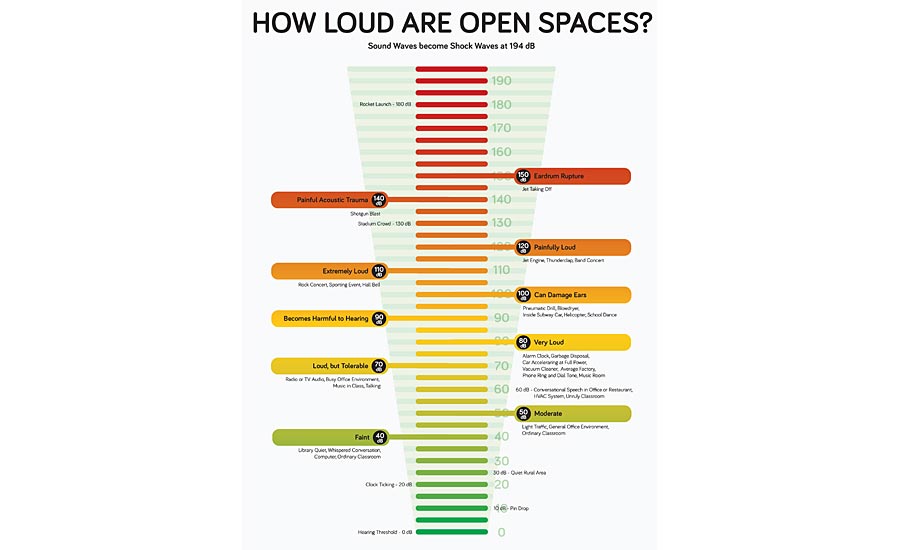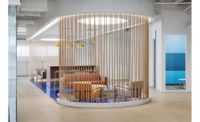Wide, open interior spaces are appealing on so many levels — functionality, style, a place for collaboration. Natural light, high ceilings, concrete flooring, exposed ducts and many windows are the epitome of modern work and play. It’s all very cool — until somebody starts talking.
For all its virtues, experts say the open space design trend is wreaking havoc on hearing, physical health, stress levels and productivity. At many offices, employees work elbow to elbow as personal workspaces shrink, along with the size of computers. According to workdesign.com, multiple studies reveal that 70 percent of workers say the biggest impact on their productivity is the conversations of co-workers or other noise. And kids have it no better, often struggling to hear teachers in noisy gymnasiums or classrooms.
Fortunately, there are many excellent ways to control noise in buildings of any type. There are many ”tried and true acoustic” products and innovative ideas, such as custom manufactured wall and ceiling panels or custom-shaped panels that are making a huge impact not only on sound control but the design aesthetic of the space. Spaces of any type — schools, churches, restaurants, theaters and open office spaces can benefit from some simple, and often relatively inexpensive acoustic treatments. Acoustic panels, sometimes value-engineered out of the original design, can be added back later with relative ease and disruption, when the unhappy owners find the noise levels in the space unacceptable.
How Noise Affects Health
High and sustained sound levels — noise pollution — can have an adverse impact on health and productivity. A sound’s loudness is measured in decibels. Sound levels below and up to 70 decibels are tolerable.1 When sound levels go above 80-90 decibels, such as alarm clocks, phone ring and dial tones, music room or car accelerating, it becomes noise that can be harmful to hearing.2 Extremely loud levels above 100 decibels, such as stadium crowd, rock concert or jet engine take-off can damage ears, especially if held for extended periods, and can cause permanent hearing loss. Here are some of the problems:
Poor Cognitive Function
“It’s too loud to think.” Noise can be distracting and affect our ability to concentrate, even comprehend. This is especially true in learning and working environments.
Miscommunication / Health Problems
Noise can affect how we communicate and easily lead to misunderstandings.
Hearing and understanding another person talking is made more difficult when sound levels are at 50-60 decibels1 such as a general office environment, classroom, HVAC system. Loud or continuous noise can cause physical problems including headaches, high blood pressure and cardiovascular disease. Studies suggest that high intensity noise causes a rise in blood pressure, increases heart beat rate and constricts the arteries to disrupt blood flow.2 Loud noises impact mental health as well, causing stress or anxiety and can possibly stimulate aggression and other anti-social behaviors.3
Decreased Productivity
Any one of these physical effects from noise can decrease productivity. At school, difficulty in hearing the teacher or distracting noises can result in loss of attention, behavioral issues or poor performance. Similar issues arise in wide, open office spaces.
How Noise Impacts Students and Schools
Most schools are “noise magnets.” Open space classrooms, band or music rooms, the cafeteria and, the biggest offender — gymnasiums, all can be acoustic nightmares.
The consequence of all this noise is significant. According to the Maryland State Department of Education, 60 percent of all learning is listening. In most classrooms, the intelligibility rating is only 75 percent with every fourth word missed. Hearing in children does not fully develop until age 13, and temporary illness such as colds or ear infections can affect hearing. All of these factors have an impact on performance scores. Teachers and coaches miss an average two days of work per year due to vocal fatigue.4
Consider a typical high school basketball game. The noise level in a crowded gym can exceed 100 decibels. At any given minute, dozens of types of sounds are bouncing off the walls. Fans yelling, referees whistling, cheerleaders cheering and music blasting at halftime contribute a myriad of jumbled sound. Yet, gymnasiums have no absorbing surfaces like carpet or furniture, and are constructed of sound-bouncing materials like wood, concrete and metal roof decks. Even worse, many high school gyms are used for other purposes like parent teacher organizations, concerts and assemblies. Occupants must try to interpret sound that has been bounced off highly reflective surfaces, resulting in excessive echoes and reverberations.
Occupational Safety and Health Administration recommends 85 decibels as a safe noise level in gymnasiums, cafeterias, music rooms, even classrooms. As the chart below demonstrates, dB lev-els often far exceed those levels.
Open Space Offices: Work Performance Friend or Foe?
The open concept design trend is popular with businesses small and large. Open workspaces bring people together, enhancing interaction and stimulating collaboration. But workspace acoustics are often overlooked, leading to everything from distractions, absenteeism, stress and loss of productivity due to ill health. According to many studies, more than 70 percent of all employees in open workspaces say that their biggest impact on productivity is the conversations of their co-workers.
Today’s workspace often involves huge overall expanses with high ceilings, oversized windows and four boundary walls that translate into elevated noise levels. Employees must tune out distracting conversations, pinging cell phones, HVAC humming, running equipment as well as exterior noises.
Noise-related hearing loss is the most prevalent occupational hazard among workers. According to the U.S. Department of Labor, since 2004 nearly 125,000 workers have reported permanent hear-ing loss. OSHA recommends that noise levels not exceed 85 decibels per eight hours worked. For outdoor jobs, construction sites, factories or warehouse environments, ear protection is a necessity. But it’s a different case for office space.
Acoustical Specialists to the Rescue
Most rooms are just giant boxes — four walls, floor and ceiling. How these open spaces are equipped can have a huge impact on how well we can hear the person speaking at the front of the room or sitting next to us. Sound reverberates or bounces off surfaces and in open spaces, without the right materials to absorb and buffer sounds, words can become unintelligible and sounds can become loud or annoying noise.
With the guidance of an acoustics company, or acoustics consultant in the instance of a complex project like a symphony hall, many problems created by noise pollution can be easily solved. Different types of sound reduction require different tactics.
To get started, the acoustics expert will need to know the following:
- Room size — width, length and ceiling height to determine room volume.
- Surface finishes — concrete, brick or drywall; wood flooring, tile or carpet; size of windows; drop ceiling or open with ductwork; even type of furnishings such as cubicle walls, uphol-stered pieces and hard table surfaces.
- Purpose of the room — classroom, lecture hall, band or music room, gymnasium, cafeteria, office space, church, theatre — all have different sound control requirements.
- Current problems — humming of HVAC or office equipment, outside noise, noise from the corridor or adjoining classrooms, excessive reverberation, unintelligible PA system, echoing, etc.
- Sound solution goal — This goes hand-in-hand with the purpose of the room. A gymnasium must reduce crowd noise while ensuring that the PA system is intelligible. A band director must be able to hear individual instruments playing. A theatre or large room must ensure the entire audience can hear clearly. Classrooms and office space must maintain a quiet environ-ment for learning and working.
Any room — no matter its size or purpose — can benefit from acoustical treatment. The right use and placement of acoustical products can enhance acoustics, sharpen the spoken word, fine-tune music, reduce annoying noises, stop reverberation and much more. As a result of improved acoustics, occupants hear better and are able to focus, learning can improve, and a quieter working envi-ronment is both pleasant and productive.
The Science of Sound
A reputable acoustics product manufacturer who may not need to physically be present to provide recommendations can achieve acoustical control in most commercial spaces. Projects that are more complicated may need the guidance of an acoustics consultant, who will perform in-space testing to solve highly technical problems.
The first mission of the acoustics expert is to break the sound wave. The first reflection point is the most discernible echo in a room; it is also the most disruptive. This reflection is the next sound heard after the direct sound from a monitor or loudspeakers. Sound goes out into the room and will bounce off walls, ceilings, windows and so on unless it is stopped. (Figure A)

FIGURE A
Sound consists of vibrations emitted in the form of waves that move through the air. It’s measured in decibels and frequency. Frequency is the number of complete oscillations per second of energy (sound) in the form of waves. Frequency is measured in Hertz (Hz).
Noise Reduction Coefficient
A commonly used one-number rating called NRC, or noise reduction coefficient, is simply the average of the absorption coefficients at 250, 500, 1000, and 2000 Hz. This simple, one-number rating can be useful for comparing the relative absorption of two acoustic products. Products such as baffles, banners and acoustic wall panels are often given an NRC.
The higher the NRC, the more sound is absorbed. For example, an NRC of 0 means no sound is absorbed; an NRC of 1 indicates good absorption, but the sound absorption at every Hertz should be considered. While it may seem logical to absorb all the sound in a space, that would create an artificially “dead” zone. It is important to add in the clarity of a high frequency sound into a space. There are many products on the market that can create the right mix of high, middle and low sound frequency.
Reverberation Time
Reverberation Time is the time it takes for sound to die down completely after the source has been turned off. When measuring absorption, the reverberation time is longer in an untreated room versus a treated room. The desired reverberation time will vary depending on the room’s purpose. Too little reverberation and sound does not travel well throughout the room. But too much reverberation and clarity is lost in a confusing mish-mash of echoes. For example, when adding acoustical product to a larger room, the “sweet spot” is a reverberation time of 2.0 - 3.0 seconds.
Sound can be manipulated by using absorption and/or diffusion products. Sound absorption products, due to their open construction, reduce the noise level by breaking the sound waves of each frequency. These products are designed to reduce reverberation time while maintaining consistent sound quality.
Sound diffusers enhance the quality of interior sound by spreading the sound waves more evenly across the room, avoiding “flutters” caused by standing sound waves. Sound diffusers are installed on walls, in ceiling grids or hung like clouds for open ceiling designs.
Special acoustic treatment components include wall panels, banners, baffles, clouds, reflectors, image panels, custom-shaped panels, ceiling panels and wall and ceiling diffusers. Each product has a specific use and benefit.
Basic Rules of the Acoustic Road
Consider the typical open space office again. With high, exposed ductwork ceilings and hard surface floors, the traditional sound absorbers (acoustic ceilings and carpet) have gone the way of huge desktop computers. In their absence, it’s up to the acoustics consultant to find new and creative ways to add sound absorption. Here are some of the tricks of the trade:
Ceilings
Generally speaking, ceilings are treated first in any acoustic project. In many interior spaces, ceilings offer the best location for acoustical treatments. There are special products available for exposed joists and ceiling decks while absorbing, diffusing or reflecting sound.
One of the most basic and cost-effective solutions is to attach flexible banners to the metal decking in a ceiling. These floating systems can be attractive, and when installed in high ceilings, seem to blend in with the decor and go unnoticed. Surprisingly, not a lot of acoustic material is needed for most jobs. Usually, between 30-50 percent coverage is all that is necessary on a ceiling. Acoustic clouds are increasingly important in open spaces, as they can be custom designed to enhance the aesthetics of a space. Other options for ceilings include baffles, reflectors and panels.
Shaped ceilings such as peaked, vaulted, coffered or barrel-shaped offer special challenges. Normally these types of ceilings require a site built acoustic system; however, these ceilings can benefit from properly placed acoustical panels, banners, baffles or clouds.
Walls
While there are no set rules when it comes to walls, back walls — or the wall with first sound reflection — often require more attention. The lower portions of high walls are also important to treat with acoustic products, especially in noisy environments like schools. If there is something noisy such as a copier, placing treatment on the wall near the sound source is ideal for breaking the sound wave. Acoustic panels are ideal for walls and come in a variety of sizes, thicknesses, shapes, colors, fabrics and paints. They are often customized specifically for the client.
The natural light offered by windows and curtain walls in spaces is in high demand, but can also be a headache for sound control. More acoustical product is needed for rooms with large expanses of windows or glass-walled conference rooms. The actual product used is based on the room’s size and purpose.
A Lasting Investment for Durability and Maintenance
Good news: acoustic treatments can be added at any time, usually with a minimal amount of disruption of the space. So if sound absorption products were not included as part of original con-struction, after market add-on acoustical products are available anytime.
Acoustic treatments don’t wear out over the life of a building. With proper care and occasional maintenance, they can last up to 30 years or more. In fact, they usually long outlast style and décor. Interior designers often take advantage of cutting edge new options in fabric, custom cuts, acoustic paints and other modern design options to customize a space.
Not surprisingly, a proper installation of any type of acoustic product is essential. Selecting the right mounting can cut costs and improve production times.
Maintenance is a breeze. Most acoustical products can be cleaned with a vacuum or a dry or damp cloth, depending on the material of the products used. The installing contractor provides the cleaning instructions to the customer. In very few cases, professional cleaning such as required for upholstery is needed.
Acoustics and LEED Credits
Noise pollution is addressed in LEED criteria because of its relation to human health. Acoustic products can help architects meet LEED requirements for schools and existing buildings. In schools, credits are given for low emitting materials and acoustical performance. More information can be found here.
Existing buildings are rated on occupant comfort. Creative use of acoustical products can also contribute to innovation in design. An acoustics expert can help determine which products may best suit LEED requirements.
A Wise Investment for Health and Productivity
Let’s face it; basic box structure with wide, open spaces is here to stay. To ensure these environments suit their purpose with style, function and comfort — including appropriate noise level reduction — acoustical treatments are a necessity.
Whether for schools, offices or other open, public spaces, acoustical products applied properly to ceilings and walls can add color, style and visual interest. More importantly, acoustical products serve a great function by reducing noise pollution. Acoustical treatments to wide, open spaces protect hearing, physical health, stress levels and productivity of the occupants. And that’s an investment worth making.
References
1 The Adverse Effects of Noise Pollution on Humans and Animal Health,
2 What Are the Harmful Effects of Noise Pollution? By Bhishm Khanna
4 Source for statistics in this paragraph is the Maryland State Department of Education.












Report Abusive Comment